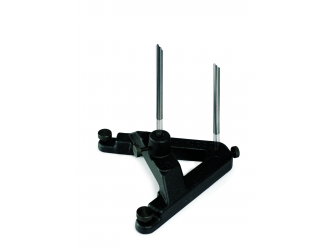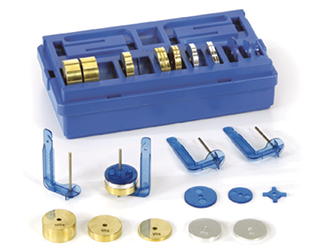Description
A P-V diagram is generated as a heat engine is taken through a cycle. From this diagram, the heat added to the gas and the work done by the engine are measured to determine the efficiency of the engine. This actual efficiency is compared to the theoretical maximum efficiency.
The heat engine consists of air inside a cylinder that expands when an attached can is immersed in hot water. The expanding air pushes on a piston and does work by lifting a weight. The heat engine cycle is completed by immersing the can in cold water, which returns the air pressure and volume to the starting values.
The cycle is performed as follows:
-
- With the can in the cold bath, the 200 g mass is placed on the platform.
- The can is moved from the cold bath to the hot bath.
- The 200 g mass is removed from the platform.
- The can is moved from the hot bath to the cold bath.
The change in pressure is measured with a Low Pressure Sensor. The change in piston height is measured by the attached string over the Rotary Motion Sensor pulley. The change in volume is calculated by multiplying the change in piston height by the piston cross-sectional area.
PASCO Advantage: This operating heat engine shows how a difference in temperature can be used to do work. Each part of the cycle is easily identifiable, and the actual efficiency as well as the maximum possible efficiency can be easily determined.
Designed for use with any of the following
- 850 Universal Interface
- Any PASPORT interface with 3 ports
Concepts
- Heat engine efficiency
- Isothermal processes
- Isobaric processes
- Ideal Gas Law
Experiments
What’s Included
- 1x Heat Engine/Gas Law Apparatus (TD-8572A)
- 1x Large Rod Base (ME-8735)
- 1x Mass and Hanger Set (ME-8979)
- 2x 3-Liter Plastic Tub (2-Pack) (ME-7559)
- 1x Thread
- 1x 90 cm Stainless Steel Rod (ME-8738)
- 1x PASPORT Rotary Motion Sensor (PS-2120A)
- 1x PASPORT Quad Temperature Sensor (PS-2143)
- 1x PASPORT Dual Pressure Sensor (PS-2181)
Software Required
This product requires PASCO software for data collection and analysis. We recommend the following option(s). For more information on which is right for your classroom, see our Software Comparison: SPARKvue vs. Capstone »
Interface Required
This product requires a PASCO Interface to connect to your computer or device. We recommend the following option(s). For a breakdown of features, capabilities, and additional options, see our Interface Comparison Guide »











